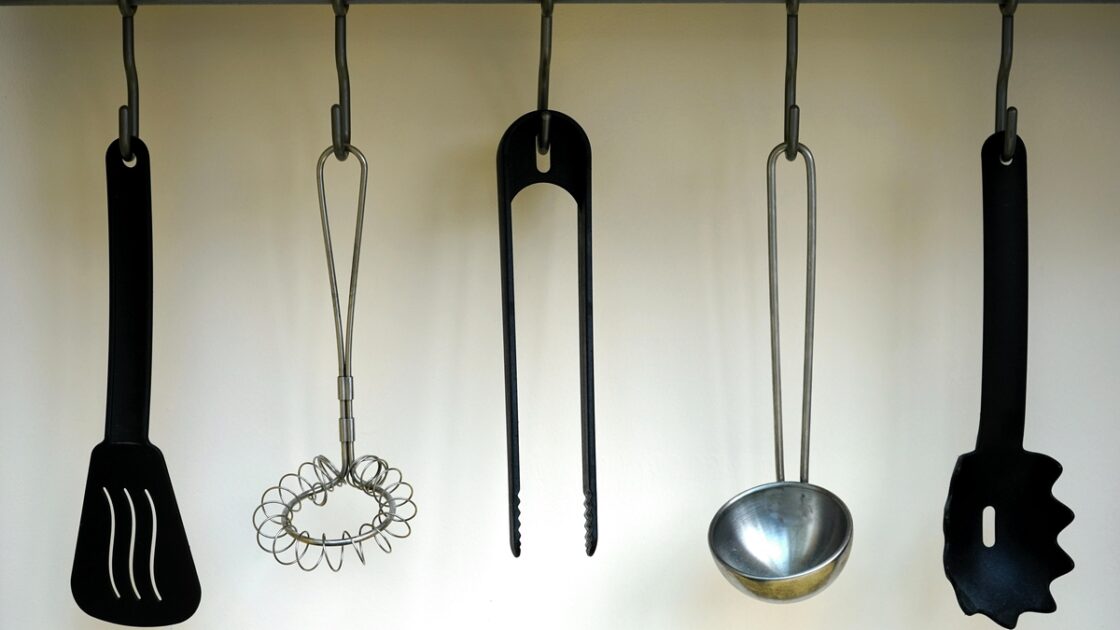
You’re already a convert to non-toxic cookware, like the colorful pieces from Caraway or the innovative, ceramic-coated nonstick from GreenPan. But just because you’ve upgraded your cookware doesn’t mean your kitchen is non-toxic. It’s high time you gave the same care and attention to your cooking utensils, too.
The Risks of Conventional Cooking Utensils
Plastic cooking utensils are ubiquitous in kitchens across the country. It makes sense, given their easy utility and affordable price tag. But the environmental effects of the plastic industry are wide-ranging and devastating, with an overreliance on fossil fuels compounded by the dangers of the rising presence of microplastics and nanoplastics1. The use of plastic utensils ultimately results in plastic waste, which we all know has long-term consequences on our planet.
Want more top picks? Sign up for the newsletter for more well-researched, non-toxic living guidance and smart wellness advice.
Beyond the macro level, plastic utensils aren’t great for you on a micro level, either — they can release toxic chemicals like flame retardants and phthalates into your food. In fact, a 2024 study in Chemosphere found that kitchen utensils contain one of the highest levels of flame retardants of all the consumer products they tested2. Black plastic kitchen utensils were especially bad, as they’re often made with recycled electronic waste. Exposure to these toxic substances could harm your reproductive, immune, and neurological systems3, and has been linked to health conditions like thyroid disease4, cancer, and diabetes5. No one wants that in their food.
Non-toxic cooking utensils may be a bit more costly in the short-run — but given their safety and longevity, the long-term investment is more than worthwhile.
So Which Cooking Utensil Materials Are Safe?
No matter which material you choose for your non-toxic cooking utensils, there are a few overarching guidelines to keep in mind. For the safest kitchen utensils, seek out tools devoid of harmful chemicals like BPA, PTFE, and PFOA, all of which can be found in some plastics or rubbers. And be sure to look for FDA-approved materials, which must meet strict safety standards. With that in mind, here are the materials we recommend for safe utensils for cooking.
Stainless Steel
Stainless steel is non-toxic, non-reactive, long-lasting, and durable. It’s easy to clean, dishwasher-safe, and versatile.
There are, nevertheless, a few potential downsides to cooking with stainless steel. Some stainless steel contains nickel, which can cause adverse reactions in people with a sensitivity to the metal6. And metal cooking utensils can reduce the durability of certain coated nonstick pans or enamel-coated pans.
If you’re mostly cooking in carbon steel or stainless, go ahead and grab a gleaming set of utensils to match. But if you’re looking for tools to use with your favorite enamel-coated cast iron from Staub or non-toxic nonstick from GreenPan, there are better materials to choose from.
Wood & Bamboo
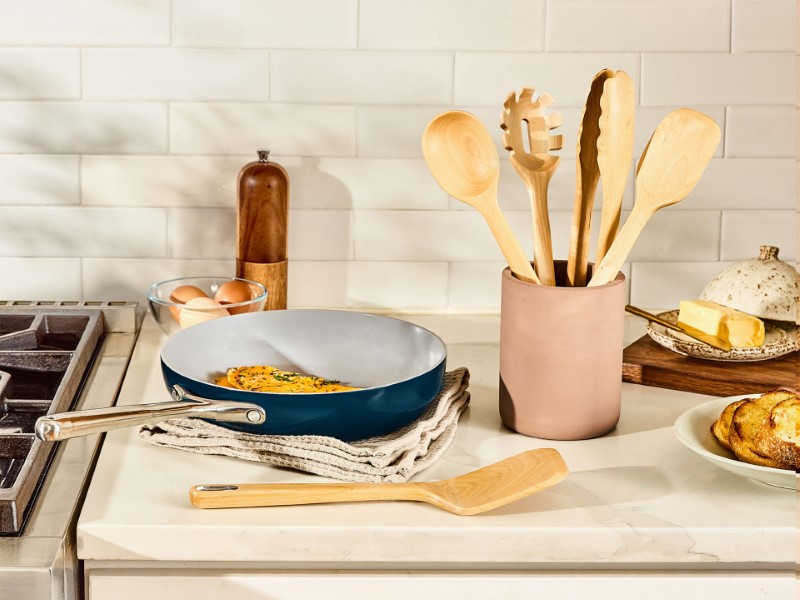
Wooden cooking utensils are an all-natural option that’s more energy-efficient to produce than plastic or metal. Bamboo is an even more sustainable option, given its biodegradability and quick-growing nature. If you’ve got your eye on natural wood or bamboo utensils for cooking, look for at Forest Stewardship Council (FSC) certification to ensure the sustainability of the source.
Given that wood is a porous material, some have raised concerns about its potential to absorb dangerous bacteria, which could then contaminate your meals. Luckily, researchers have debunked this theory: a UC Davis study found that wooden tools like cutting boards do not sustain bacteria on their surfaces7. Rather, the bacteria sinks beneath the surface of the tool and eventually dies. Dr. Ben Chapman, a professor and food safety researcher at North Carolina State, told Martha Stewart Living that as long as wooden utensils are drained and dried properly between uses, they are safe to use8.
One final point of caution when it comes to the potential toxicity of wood or bamboo utensils is the finish. Some wood varnishes can be toxic, so be sure to seek out unfinished utensils and to care for them with food-safe finishes like mineral oil.
Food-Grade Silicone
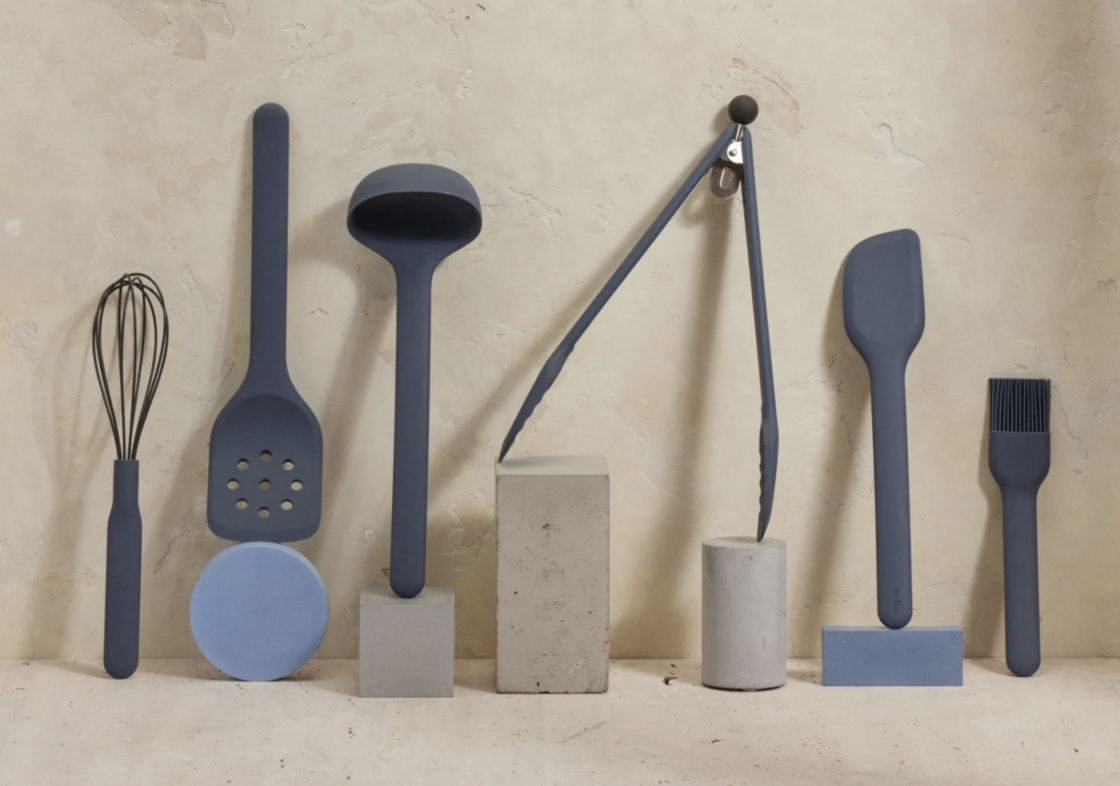
Silicone is a common choice for cooks looking to care for their prized cookware, seeing as it’s gentle even on non-toxic nonstick. But when selecting silicone cooking utensils, it’s important to seek out a trustworthy source.
A 2023 research review in Comprehensive Reviews in Food Science and Food Safety revealed that these utensils can vary widely in terms of quality, with the lower-quality tools potentially containing chemical residues9. These utensils also have the potential to degrade over time, especially when used at particularly high temperatures.
Look for BPA-free silicone from a trustworthy source, and be sure to adhere to user instructions from the manufacturer to ensure that your tools don’t degrade.
Our Top Picks for Non-Toxic Cooking Utensils
To get you started in your search, here are a handful of our favorite non-toxic kitchen utensils in a variety of materials.
Birch Wood Utensils from Caraway
Caraway is known for the beauty of its cookware, so we’re not surprised its utensils are just as gorgeous. This sleek and streamlined set of wooden spoons, spatulas, and tongs offers far more than just a pretty face.
The utensils are made from FSC-certified birch, known for its durability and sustainability. Birch trees grow more quickly than others, making them a fairly renewable resource. Plus, the true hardwood is fairly scratch-resistant, with a fine, even texture — meaning these lovely tools are made to last. This five-piece utensil set comes with all the essentials — you’ll have to look elsewhere for additional servers like a ladle or slotted spoon, but this is a great place to start.
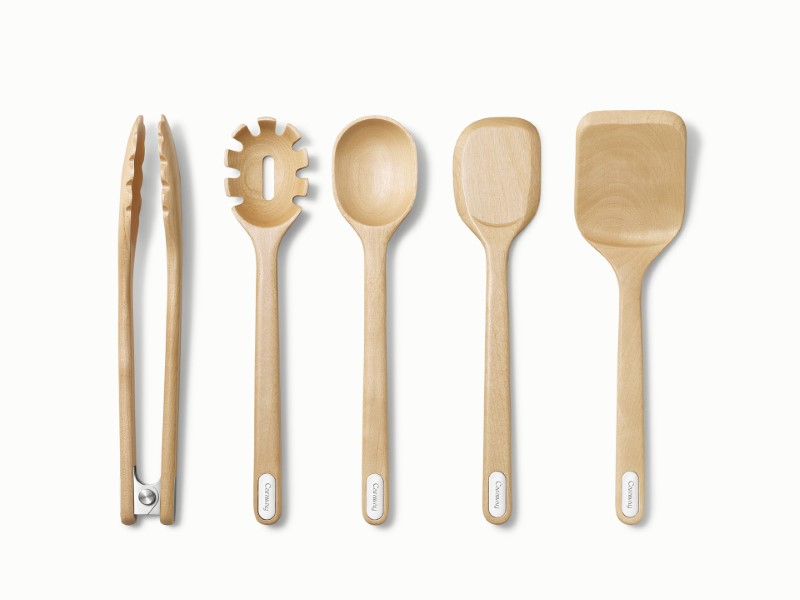
Specs:
- Wooden spoon
- Wooden server
- Wooden scraper
- Wooden spatula
- Wooden tongs
Price: $125 at time of publish
No-Nonsense Food-Grade Silicone Utensils from GreenPan
GreenPan’s pioneering nonstick is ideally paired with gentle, food-safe silicone, and it’s hard to beat the tools the company sells in generous sets of six or eight. Each piece is made with platinum silicone, which is preferred for medical-grade products given its wider temperature range and increased durability. As a result, the sets are heat-resistant and oven-safe up to 392 ºF.
A rigid steel core gives these tools extra stability, but flexible edges and an anti-slip grip makes them more comfortable to handle than metal tools. Available in either black or Oxford blue, these dishwasher-safe tools are the very definition of low-maintenance cookware.
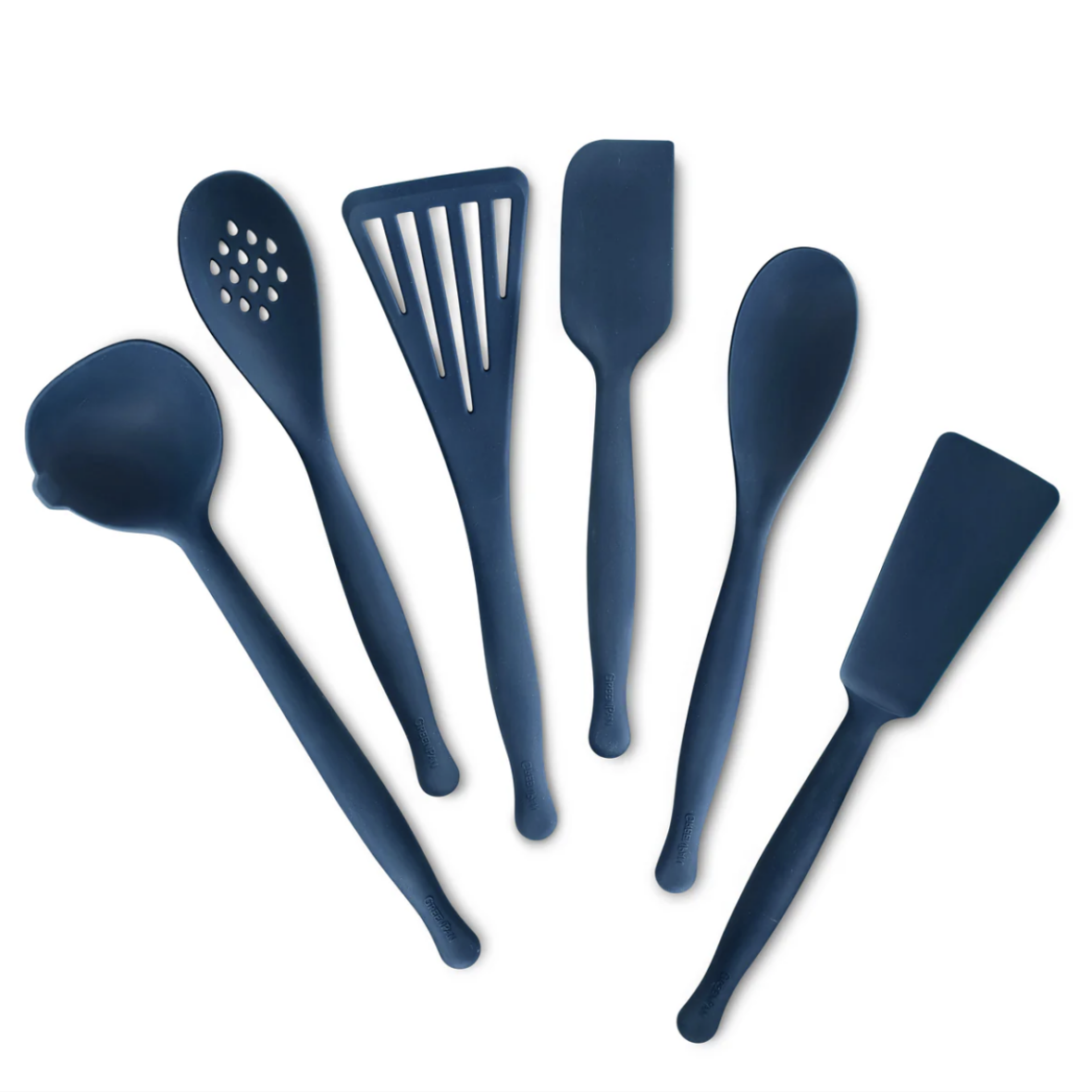
Specs:
- Silicone solid spoon
- Silicone slotted spoon
- Silicone dough scraper
- Silicone ladle
- Silicone burger turner
- Silicone fish turner
- Silicone ball whisk (sold only in the eight-piece set)
- Ceramic storage crock (sold only in the eight-piece set)
Price: $99.99 at time of publish
Minimalist Class with Stainless Steel Utensils from Made In
The stainless steel, carbon steel, and cast iron cookware from Made In is loved by chefs around the world, so it’s no wonder their utensils are just as thoughtfully designed. Sleek and lightweight while also being durable and sturdy, these utensils boast lovely blue accent handles made for showing off.
Made In’s 5-piece utensil set is made with dishwasher-safe 304 Stainless Steel, with the exception of the silicone spoonula (which is made to be used with nonstick cookware). The stainless steel construction means these tools are durable and easy to clean, but it also means you won’t be able to use them with your nonstick or enamel-coated cookware. Still, if you rely mainly on your Made In pans, these tools are the perfect companions for your cookware.
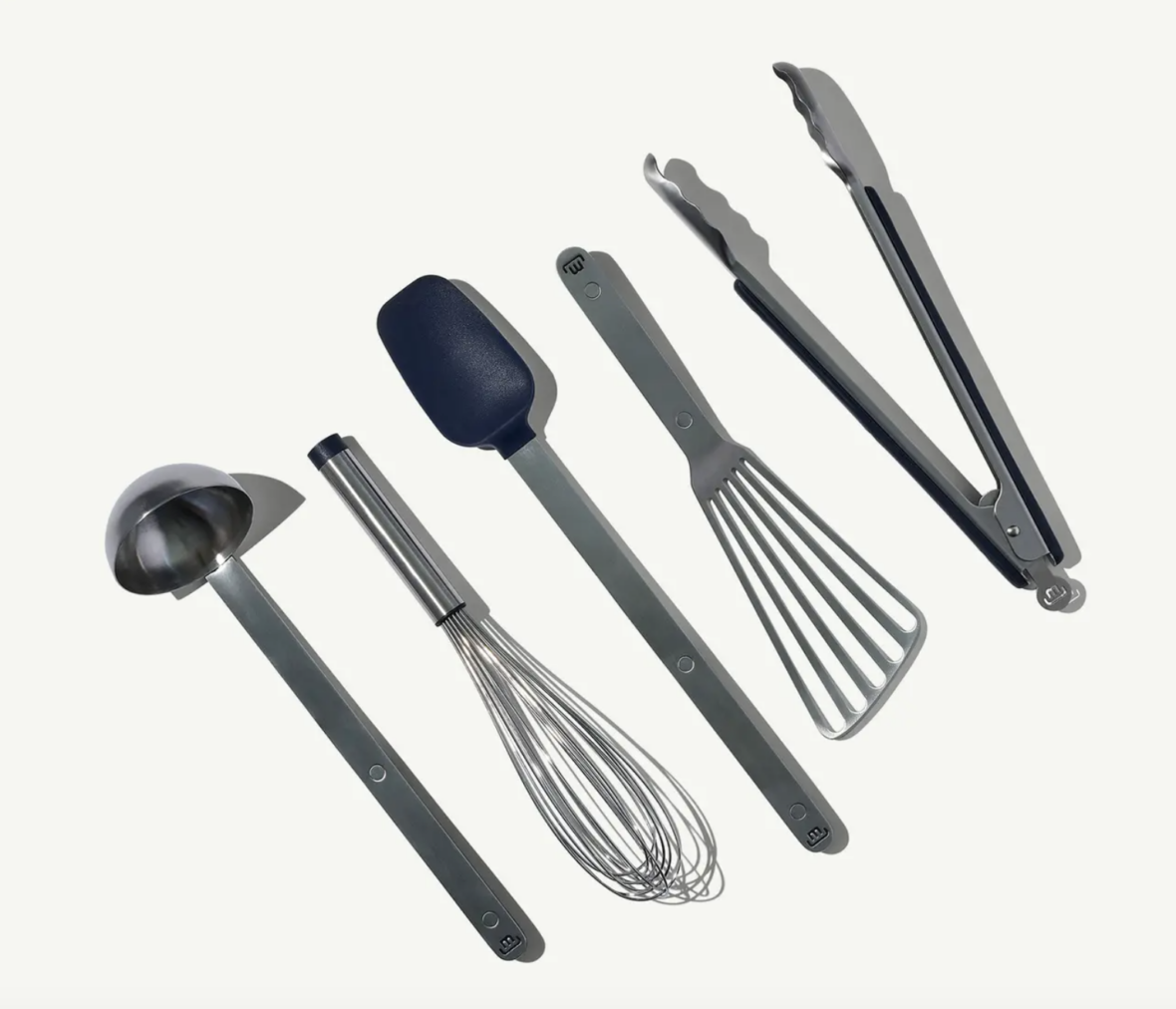
Specs:
- Stainless steel ladle
- Stainless steel tongs
- Stainless steel whisk
- Stainless steel and silicone spoonula
- Stainless steel fish turner
Price: $79
The Best of Both Worlds with Staub
Staub’s enamel-coated pans are some of our finest kitchen treasures, and the silicone utensils sold by the company offer the best way to take care of them. These utensils marry form and function with gorgeous acacia handles and food-safe, BPA-free silicone heads that are safe to use on all cookware, even nonstick. These tools are best maintained by hand-washing, but they’re well worth the extra effort.
We also love that these utensils are available in a variety of different bundles, depending on your needs. Those looking to begin their transition to non-toxic cooking utensils can snag the five-piece starter set ($74.99), while those ready to take the plunge could go for the 11-piece set.
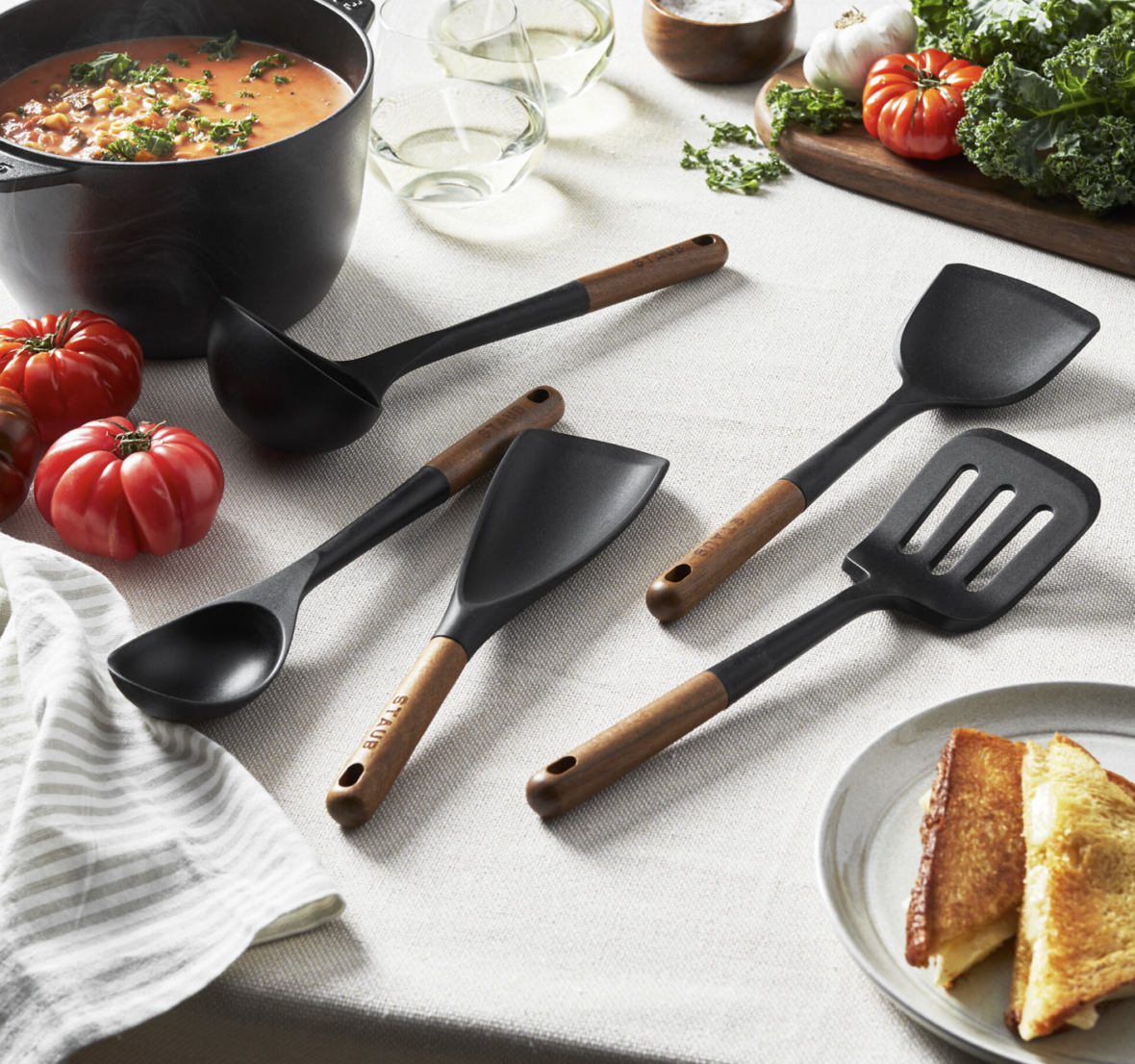
Specs (5-piece set):
- 2-in-1 multi-function silicone spatula spoon
- Silicone ladle
- Silicone wok turner
- Silicone slotted turner
- Silicone serving spoon
Price: $74.99
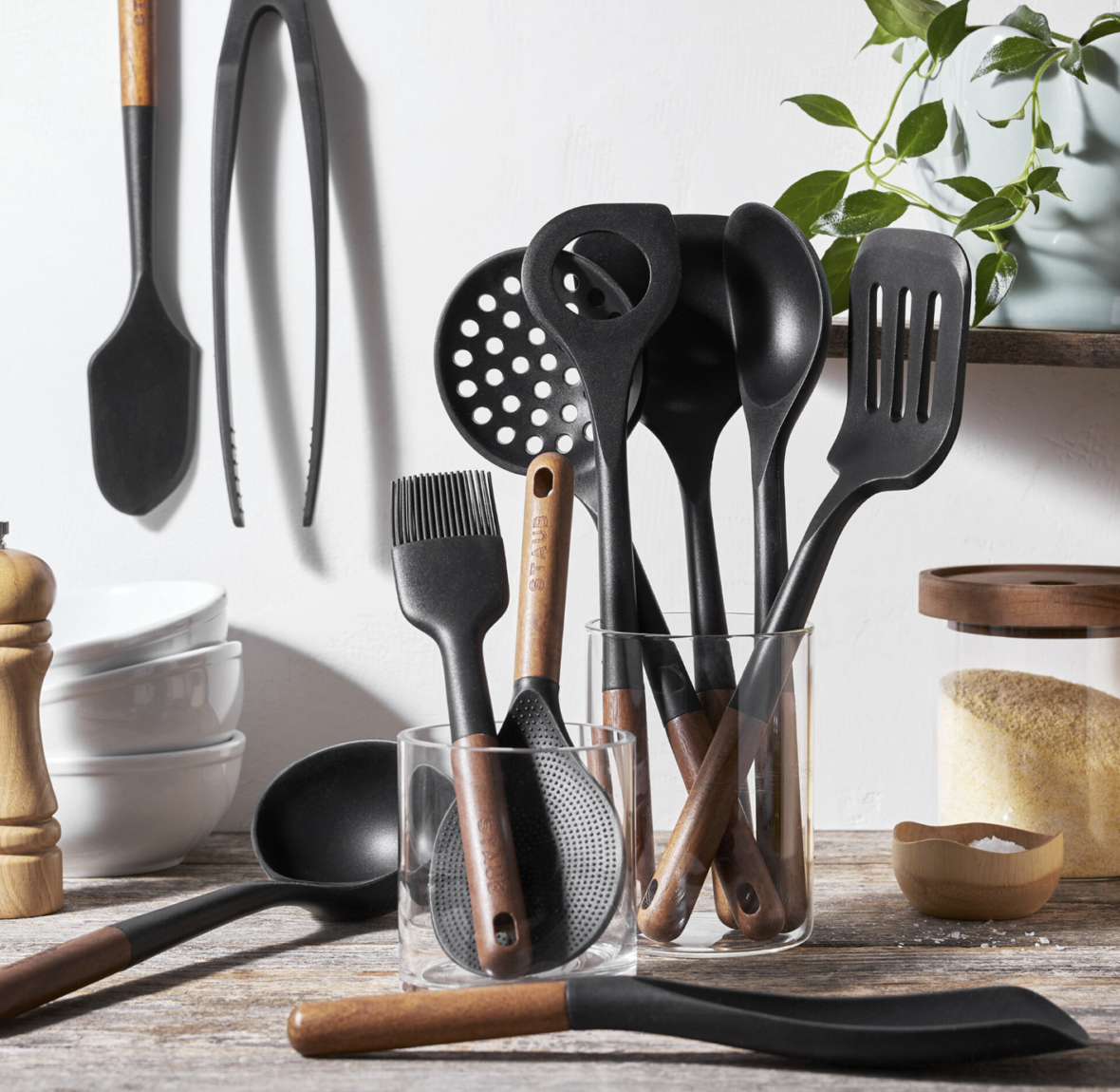
Specs (11-piece set):
Includes everything in the 5-piece set, plus:
- Silicone risotto spoon
- Silicone spatula
- Silicone skimming ladle
- Silicone tongs
- Silicone pastry brush
Price: $149.99
Heat-Resistant Silicone from Our Place
The food-safe silicone tools from Our Place are some of the most versatile on this list. Not only are they dishwasher-safe, but they can be used at temperatures of up to 450 ºF, meaning you can even fry with them. To top it all off, they boast a sleek, simple design and ergonomic handles that stay nice and cool as you cook.
The six-piece set comes in their Steam or Blue Salt/Char colorways to perfectly match your kitchen aesthetic.
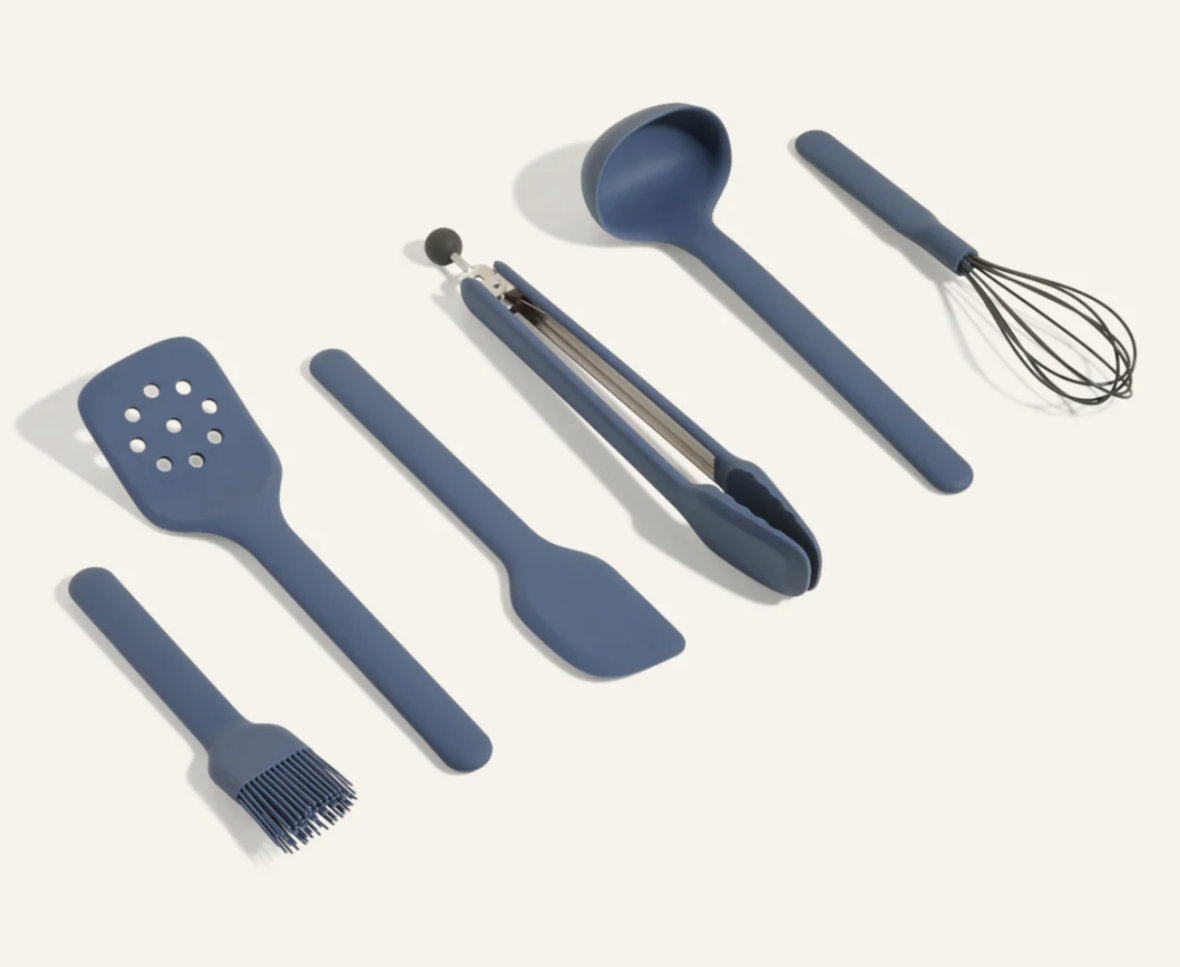
Specs:
- Silicone spatula
- Silicone ladle
- Silicone whisk
- Silicone slotted turner
- Silicone basting brush
- Silicone tongs
Price: $64 at time of publish
How to Care for Your Non-Toxic Cooking Utensils
The utensils you choose will dictate how they’re cared for. Metal utensils are by far the most low-maintenance, seeing as they’re dishwasher-safe, dry quickly, and aren’t prone to degrading like silicone and wood. Wood should always be hand-washed to ensure its longevity, but best practices for silicone depend on the quality of the material used. When in doubt, it’s best to check with the manufacturer.
When it comes to high-heat cooking methods, be aware that silicone can begin to degrade when heated above certain temperatures. Consider relying instead on wood or metal for high-heat preparations like frying, simmering, or boiling.
Wooden utensils demand a bit more TLC to stay in the best shape. Avoid soaking them whenever possible, and oil them with food-safe mineral oil or a beeswax-based cream (like this one from John Boos) if they start to dry out. Make sure the tools are completely dry before lathering them up in oil or cream, and leave them to sit overnight so that they can absorb all that moisture. By morning, they’ll be good as new.
The Key to a Successful Transition
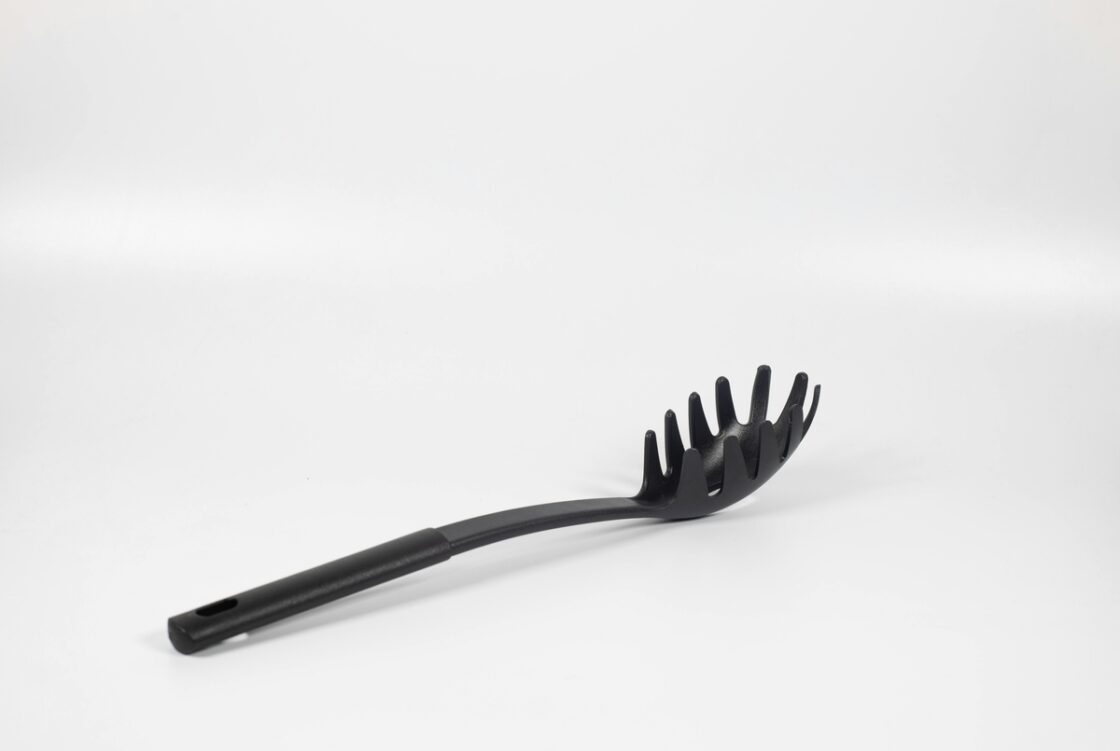
Overhauling your kitchen to be more sustainable and non-toxic can be quite the endeavor, but there’s no reason you need to change everything all at once. Take it one step at a time! Here are the top two categories we recommend replacing sooner rather than later:
1. Plastic Tools You Constantly Reach for
The best kitchen utensils to replace first are the ones you use the most often. Do you have a black plastic spatula you use every Sunday for brunch pancakes? Consider swapping it for a silicone spatula with a beautiful acacia wood handle from Staub. Is there a metal spoon you’ve been using to bring up the fond at the bottom of your cast iron pot when you make a homey stew? Try a bright red silicone sauté spoon with a metal core from GreenPan instead — it’ll have the same heft you need without causing wear and tear on your pans.
2. Plastic Tools With Signs of Damage
Plastic tools that show signs of damage are more likely to leach toxic chemicals, so it’s time to get rid of them ASAP. You know it’s time to replace your kitchen utensils when you notice any of the following:
- Discoloration, yellowing, or white spots
- Warping or shape changes
- Loss of shine or dull patches; surface texture changes
- Increased flexibility or softening of the material
- A weird odor
- Melted or burned spots
- Visible stress marks or cracking
Finally, if you’re willing to invest a bit more now to transition your kitchen all at once, you could also opt for the FSC-certified wooden set from Caraway and save a bit in the process.
Regardless of if you choose to replace items slow and steady or in one fell swoop, you should feel excited about the steps you make towards stocking a completely non-toxic kitchen.
Read More:
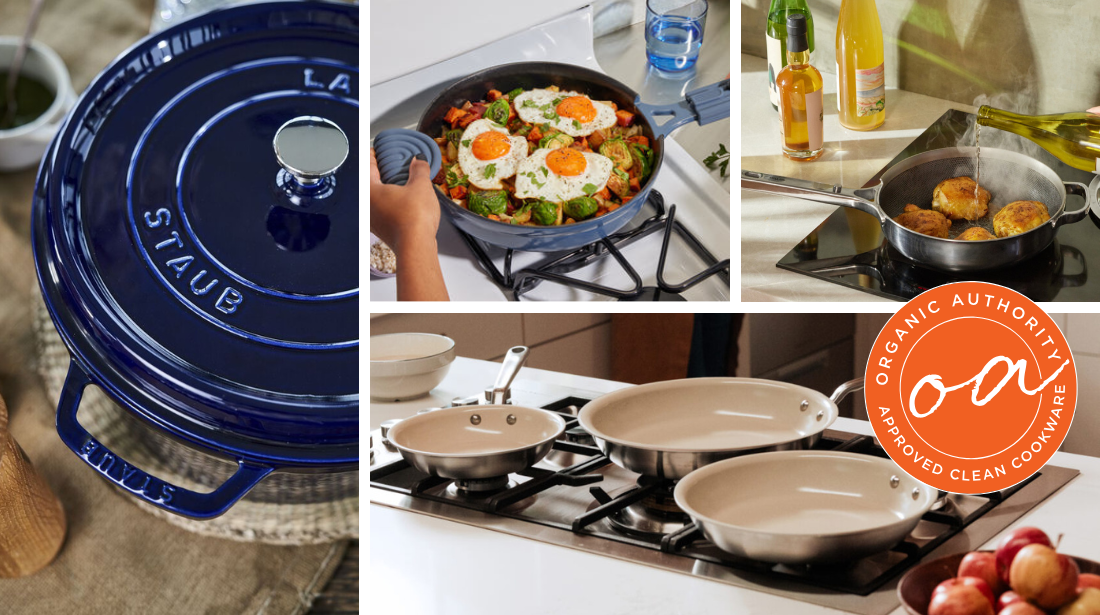
Sources:
- https://www.nrdc.org/bio/renee-sharp/hidden-fossil-fuels-plastic-production-drives-climate-change
- https://www.sciencedirect.com/science/article/abs/pii/S0045653524022173?via%3Dihub
- https://www.sciencedirect.com/science/article/abs/pii/S0269749121010575
- https://ehjournal.biomedcentral.com/articles/10.1186/s12940-016-0141-0
- https://pmc.ncbi.nlm.nih.gov/articles/PMC10486428/
- https://pubmed.ncbi.nlm.nih.gov/25747857/
- https://pubmed.ncbi.nlm.nih.gov/16640304/
- https://www.marthastewart.com/wooden-spoons-safe-8760891
- https://pubmed.ncbi.nlm.nih.gov/37183940/

